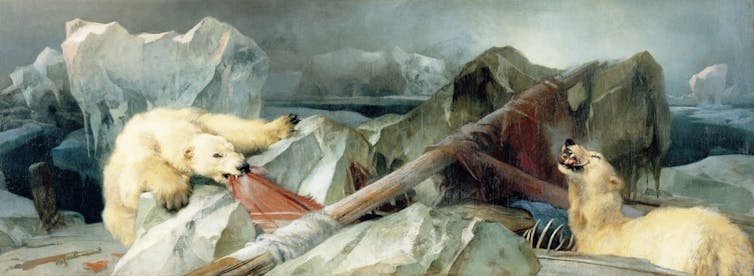A polar bear sleeps perched atop a precariously angled shard of melting ice. The bear’s calm is juxtaposed by the frenetic waves lapping at the little island, suggesting that at some point the sea will reclaim it. This is the scene, captured by the photographer Nima Sarikhani, that has won this year’s Wildlife Photographer of the Year People’s Choice award.
When I saw this picture had won, I had mixed feelings.
Don’t get me wrong, the photograph is stunning and fully deserves praise. But the subject of a lone bear on a small patch of ice remains, for me, laden with problems. In the 2015 film This Changes Everything, the writer Naomi Klein famously stated that images of “desperate polar bears” were so regularly used in the media that they had begun to bore her.
She didn’t mean that she didn’t care but wanted to draw attention to the way that certain images or motifs lose power the more they are repeated. Was it useful for the environmental movement to keep fixating on polar bears when countless other species were also suffering or when there are, perhaps, more original ways of communicating the issues at hand?
Up until recently, I’d been persuaded by Klein’s argument. Popular messaging around climate change is saturated with images of polar bears and it can be hard to maintain interest. However, that Sarikhani’s photograph received the People’s Choice award is one of many indications that the power of the polar bear is not as diminished as some think it is. Was I wrong to be bored of polar bears?
About a year ago, I started approaching this question from another angle by looking at how polar bears have been depicted in the past.
Beyond photographs
As an expert on 19th-century art and visual culture, I’ve frequently encountered polar bears in Victorian paintings, yet I hadn’t given them a second thought.
I decided to explore whether there was a connection between these historical works and our current fascination. I also wanted to look beyond a certain way of visualising polar bears. After all, Klein’s reservations were not about polar bears per se, but about images of “desperate” polar bears. Perhaps there are other ways of picturing them that might change the way I thought.
My research took me on a fascinating journey, from delicate Innuit sculptures of standing bears to some rather dodgy European prints in which they look rather more like white, shaggy dogs.
Through these works, I’ve learned a lot about the long and complex relationship between people and polar bears, and how polar bears have been constantly caught up in wider concerns. For example, Edwin Landseer’s famous 1864 painting Man Proposes, God Disposes represents two ferocious bears feeding among the wreckage of a ship.
Man Proposes, God Disposes is about the arctic explorer John Franklin’s famous failed expedition to discover the Northwest Passage. Here, the polar bears represent man’s violent defeat by nature.

Wikimedia
Other Victorian paintings, meanwhile, show how closely the fate of polar bears was aligned to the whaling trade in and around the north and south poles. When whales became scarce in Arctic waters, hunters would turn their attention to the trade in bear skins. Here, man’s dependence on nature is foregrounded as well as the violence enacted upon it.
While researching these pictures I decided to reach out to Doug Allan, a wildlife cameraman who has spent over 35 years filming and photographing in the Arctic. I wanted to know whether Allan could see connections between the longer history of polar bear imagery and contemporary photographs and footage of bears we see today.
Better stories
It’s fair to say that Allan has never been bored of polar bears, despite the many hours he has spent in the Arctic waiting for one to amble into view.
He shared my interest in the history of polar bears and the contexts in which their image has been used. Together, we explored the collections in the Scottish city of Perth. Objects owned by Perth Museum and Art Gallery and the Royal Scottish Geographical Society, offered me new insights into this subject.
We drew links between 19th-century paintings and the kind of footage he’s filmed for series such as Frozen Planet. Although there are many differences, these Victorian paintings and nature documentaries share the goal of trying to capture moments of high drama to communicate a message.
The conclusion we reached was that it wasn’t pictures of polar bears that were boring, the problem was the limited, often maudlin narratives that accompanied them. The images are more than cute, sad or emotional representations of climate collapse – these sorts of descriptions flatten them. Instead, they deserve explanations that tell much more complex, sometimes conflicted stories.
In relation to this, I’m still thinking about Sarikhan’s photograph – about how it differs from other contemporary polar bear images and may relate to this longer tradition of depicting bears.
Why are photos of polar bears on icebergs so popular? What other kinds of polar images are we overlooking? How would our perception of this particular photograph differ, for instance, if the bear were dead, not sleeping?
I may have mixed feelings about Sarikhan’s photograph. However, as someone who has now seen hundreds of images of polar bears, I am far from bored by it. Instead, when I look at it, I see the complex history of polar bear images and the many dramatic narratives of survival and violence that have continuously been thrust upon them.
So, if you are feeling unmoved by what you consider “just another bear on an iceberg” try thinking about the storied tradition of polar bear images, about how these have changed as our own relationship with the environment has, and I dare you to be bored.
